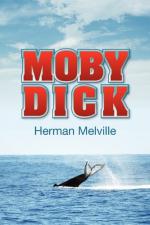If you unload his skull of its spermy heaps and then take a rear view of its rear end, which is the high end, you will be struck by its resemblance to the human skull, beheld in the same situation, and from the same point of view. Indeed, place this reversed skull (scaled down to the human magnitude) among a plate of men’s skulls, and you would involuntarily confound it with them; and remarking the depressions on one part of its summit, in phrenological phrase you would say—This man had no self-esteem, and no veneration. And by those negations, considered along with the affirmative fact of his prodigious bulk and power, you can best form to yourself the truest, though not the most exhilarating conception of what the most exalted potency is.
But if from the comparative dimensions of the whale’s proper brain, you deem it incapable of being adequately charted, then I have another idea for you. If you attentively regard almost any quadruped’s spine, you will be struck with the resemblance of its vertebrae to a strung necklace of dwarfed skulls, all bearing rudimental resemblance to the skull proper. It is a German conceit, that the vertebrae are absolutely undeveloped skulls. But the curious external resemblance, I take it the Germans were not the first men to perceive. A foreign friend once pointed it out to me, in the skeleton of a foe he had slain, and with the vertebrae of which he was inlaying, in a sort of basso-relieve, the beaked prow of his canoe. Now, I consider that the phrenologists have omitted an important thing in not pushing their investigations from the cerebellum through the spinal canal. For I believe that much of a man’s character will be found betokened in his backbone. I would rather feel your spine than your skull, whoever you are. A thin joist of a spine never yet upheld a full and noble soul. I rejoice in my spine, as in the firm audacious staff of that flag which I fling half out to the world.
Apply this spinal branch of phrenology to the Sperm Whale. His cranial cavity is continuous with the first neck-vertebra; and in that vertebra the bottom of the spinal canal will measure ten inches across, being eight in height, and of a triangular figure with the base downwards. As it passes through the remaining vertebrae the canal tapers in size, but for a considerable distance remains of large capacity. Now, of course, this canal is filled with much the same strangely fibrous substance—the spinal cord—as the brain; and directly communicates with the brain. And what is still more, for many feet after emerging from the brain’s cavity, the spinal cord remains of an undecreasing girth, almost equal to that of the brain. Under all these circumstances, would it be unreasonable to survey and map out the whale’s spine phrenologically? For, viewed in this light, the wonderful comparative smallness of his brain proper is more than compensated by the wonderful comparative magnitude of his spinal cord.




